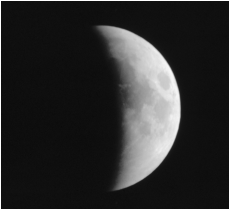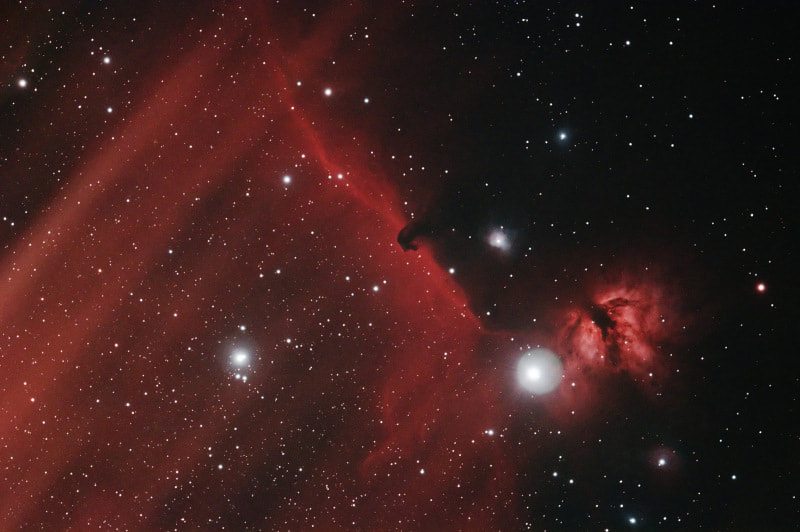Photography was a hobby I got into back in the '70s. And after I purchased my first real telescope, an orange-tube Celestron C-8, I naturally started taking photos through it with my 35mm camera (a Yashica TL-Electro and later a Canon AE-1).
Later I added a Celestron 5.5" Schmidt camera. The Schmidt was a bit more hands on than the CCD cameras I use now, and required cutting and processing film in a dark room, and printing images on photographic paper in order to display what I'd captured. But it was a good learning experience.
|
A negative of a portion of Orion taken with my 5.5" Celestron Schmidt camera, circa 1982. The camera was mounted piggyback on my C-8 with a clock motor drive, so the tracking wasn't so good. I wish I could have gotten the framing a little better to have included the third belt star.
|
The same frame inverted to a positive. What a great wide field of view through the Schmidt. And this digitized image of the negative is not stretched at all. I probably have the exposure time recorded somewhere, which I will search for, but I'm sure it is only five minutes or less.
|
CCD cameras have really changed things. Below are a few astrophotos captured with my CCD cameras as time permits, and when I'm not off chasing after some other hobby:
M8 - The Lagoon Nebula
This image was captured with an SBIG ST-8300C through a Celestron C-11. It was processed in Star Tools and then touched up a bit in Photoshop CS5.
M42 - The Orion Nebula
This image was captured with my SBIG ST-8300C through an AT6RC astrograph. It was processed in Star Tools and then touched up in Photoshop CS5.
M31 - The Andromeda Galaxy
Andromeda is a cosmic next door neighbor, as galaxies go. The final image is eight 5-minute exposures captured in Nebulosity, stacked with Deep Sky Stacker and processed in Photoshop CS5.
Taken with an Orion Starshoot Pro V1 camera. The imaging scope was a Celestron C80ED refractor equipped with a Telescope Systems (TS) field flattener. The mount is an Atlas EQ-G (EQ6).
Guiding was with PHD using a Starshoot DSCI camera thru an Orion ST-80 guide scope.
Taken with an Orion Starshoot Pro V1 camera. The imaging scope was a Celestron C80ED refractor equipped with a Telescope Systems (TS) field flattener. The mount is an Atlas EQ-G (EQ6).
Guiding was with PHD using a Starshoot DSCI camera thru an Orion ST-80 guide scope.
Horsehead and Flame Nebulas
Taken with an Orion Starshoot Pro V1 camera through a Celestron C80ED refractor and TS field flattener. The mount was an Atlas EQ-G (EQ6) controlled by EQMOD.
This is a stack of ten 5-minute exposures captured in Nebulosity, stacked with DeepSkyStacker and tweaked in Photoshop CS4. The Noise Ninja plugin was used to reduce noise.
Guiding was with PHD Guiding using a Starshoot DSCI camera thru an Orion ST-80 guide scope.
This is a stack of ten 5-minute exposures captured in Nebulosity, stacked with DeepSkyStacker and tweaked in Photoshop CS4. The Noise Ninja plugin was used to reduce noise.
Guiding was with PHD Guiding using a Starshoot DSCI camera thru an Orion ST-80 guide scope.
M33 - The Triangulum Galaxy
Taken with an Orion Starshoot Pro V1 camera through a Celestron C80ED refractor and TS field flattener. The mount was an Atlas EQ-G (EQ6) controlled by EQMOD.
It is a stack of ten 5-minute exposures captured in Nebulosity, stacked with DeepSkyStacker and tweaked in Photoshop CS4. Noise Ninja plugin was used to reduce noise.
Guiding was with PHD Guiding using a Starshoot DSCI camera thru an Orion ST-80 guide scope.
It is a stack of ten 5-minute exposures captured in Nebulosity, stacked with DeepSkyStacker and tweaked in Photoshop CS4. Noise Ninja plugin was used to reduce noise.
Guiding was with PHD Guiding using a Starshoot DSCI camera thru an Orion ST-80 guide scope.
M27 - Dumbbell Nebula
Taken with an Orion Starshoot Pro V1 camera through a Zhumell 152mm refractor with a TS field flattener and Baader Semi-APO filter. The scope was mounted on an Atlas EQ-G (EQ6) mount. It is a stack of nine 5-minute exposures captured in Nebulosity, stacked with DeepSkyStacker and tweaked in Photoshop CS4. Noise Ninja plugin was used to reduce noise and Carboni's Photoshop Actions to reduce violet fringing on the stars and to enhance the picture.
Guiding was with PHD Guiding using a Starshoot DSCI camera thru an Orion ST-80 guide scope.
Guiding was with PHD Guiding using a Starshoot DSCI camera thru an Orion ST-80 guide scope.
Comet P17-Holmes 2007
This is one of my first digital astrophotos, taken with an Orion Deep Space Color Imager on an Orion short tube 80mm refractor. It is composed of 10 frames at 10 seconds each; dark subtracted, stacked and deBayered in Nebulosity. It was post processed in Star Tools and Photoshop CS5.
About everything that could go wrong did; the refractor was out of collimation, the focus was not perfect and the camera's offset was not set high enough (the background of the light frames was between 0 and 4 ADUs). But I still got the comet.
About everything that could go wrong did; the refractor was out of collimation, the focus was not perfect and the camera's offset was not set high enough (the background of the light frames was between 0 and 4 ADUs). But I still got the comet.
Last Updated 12/29/2021













